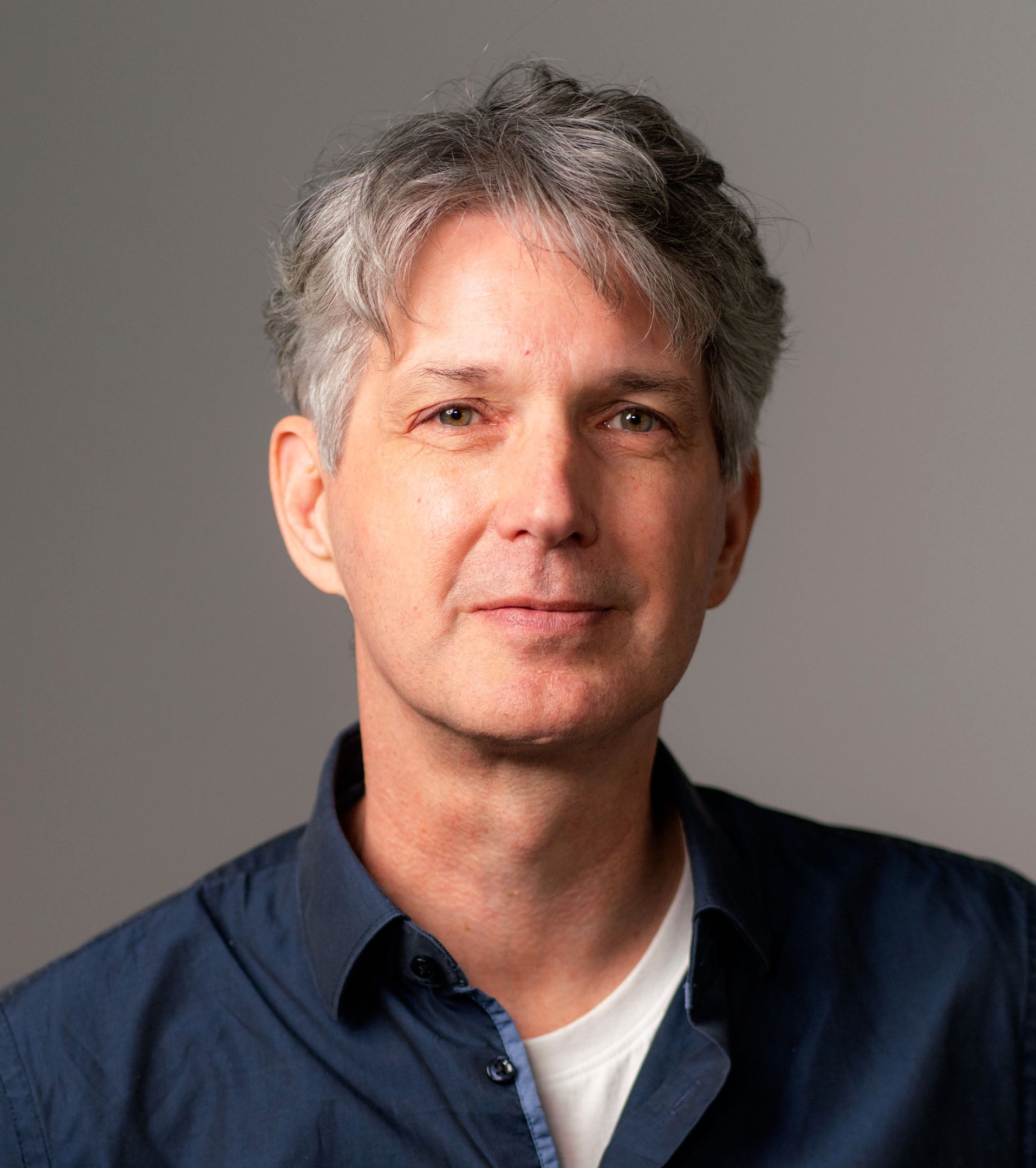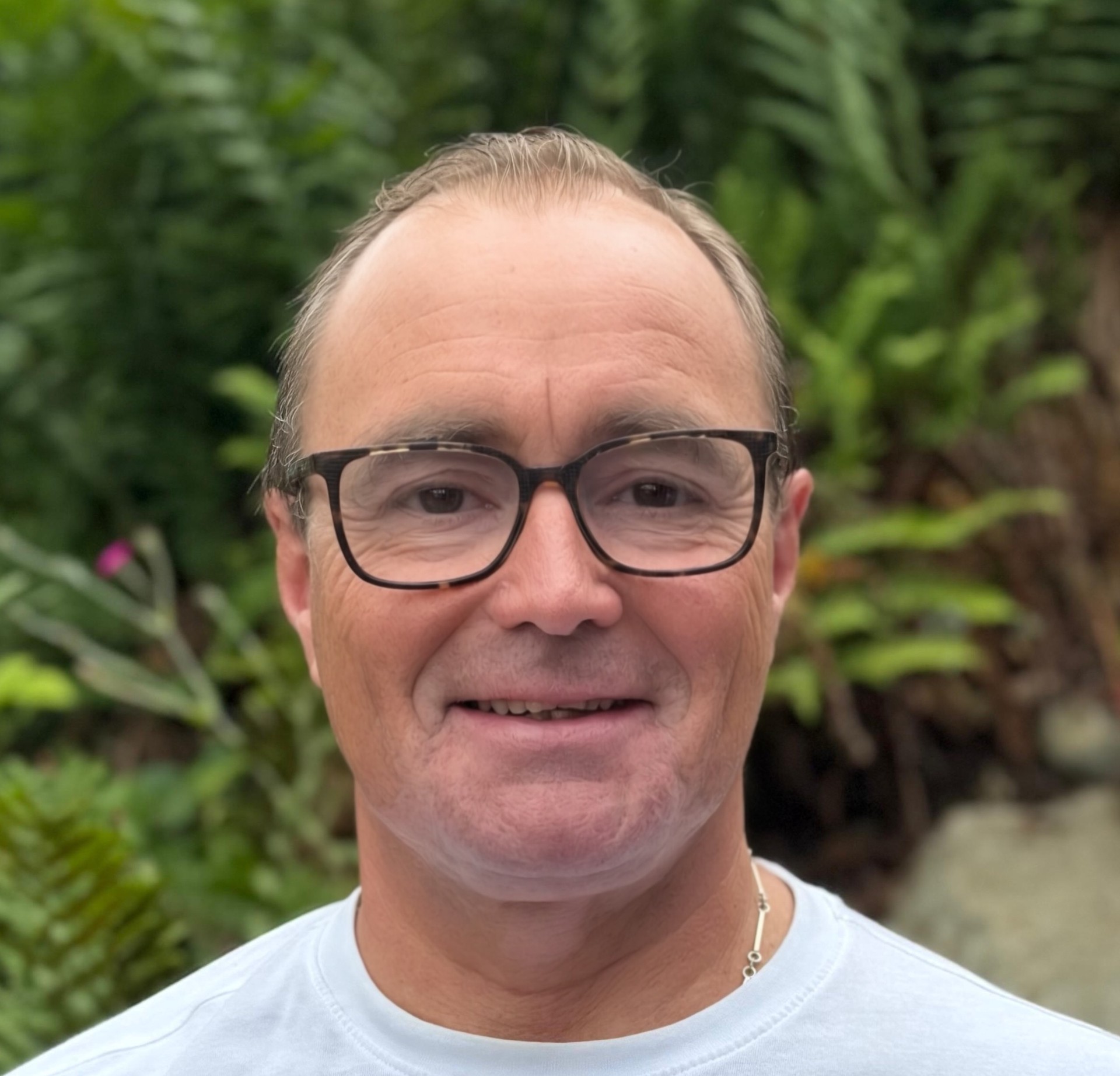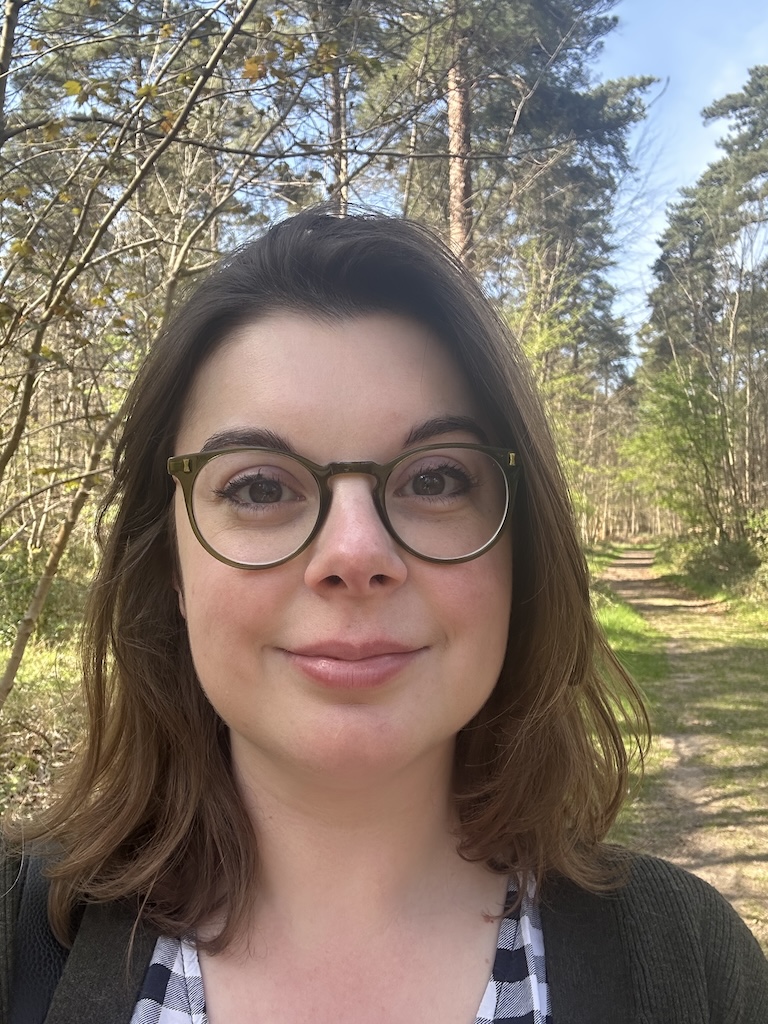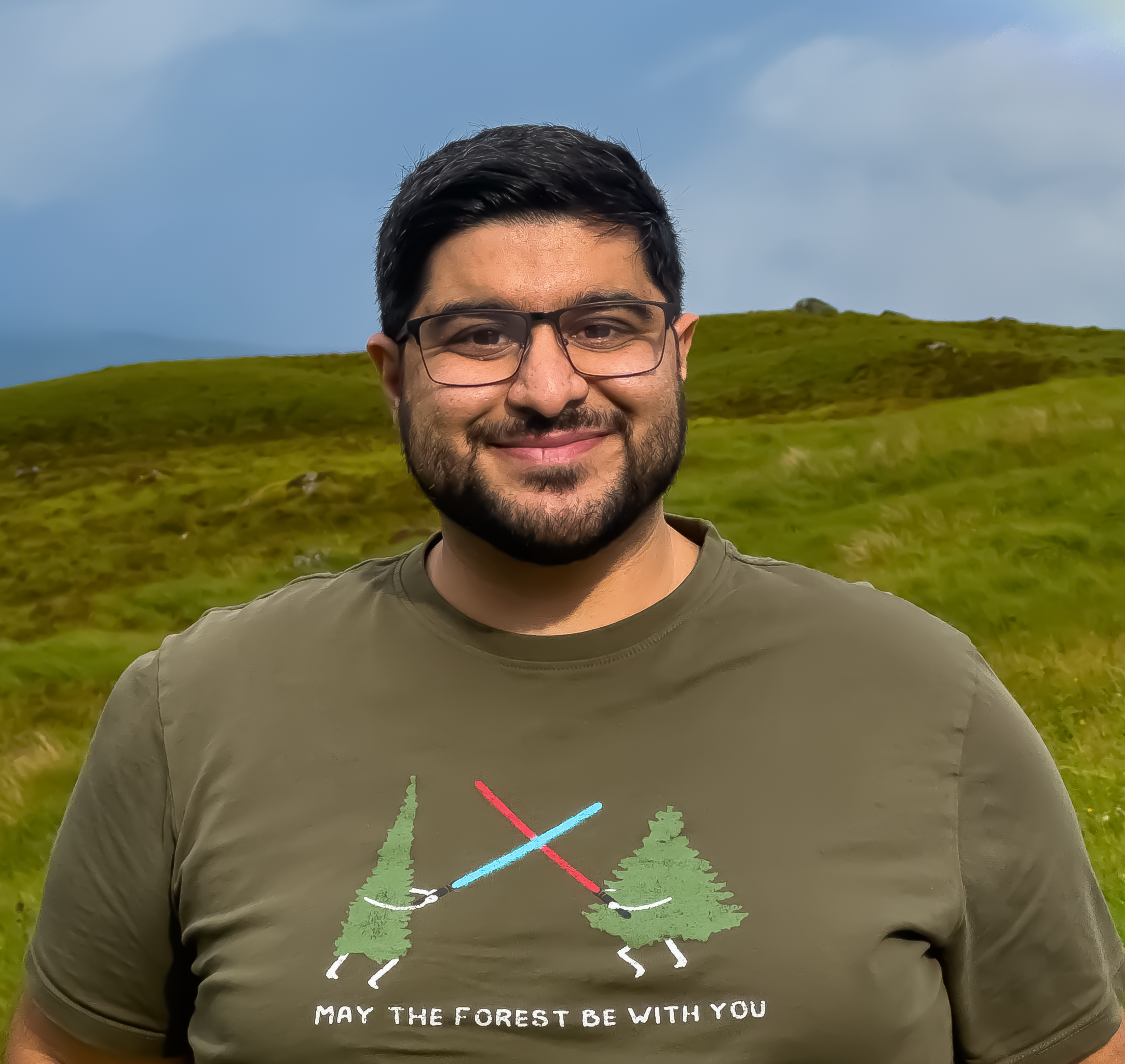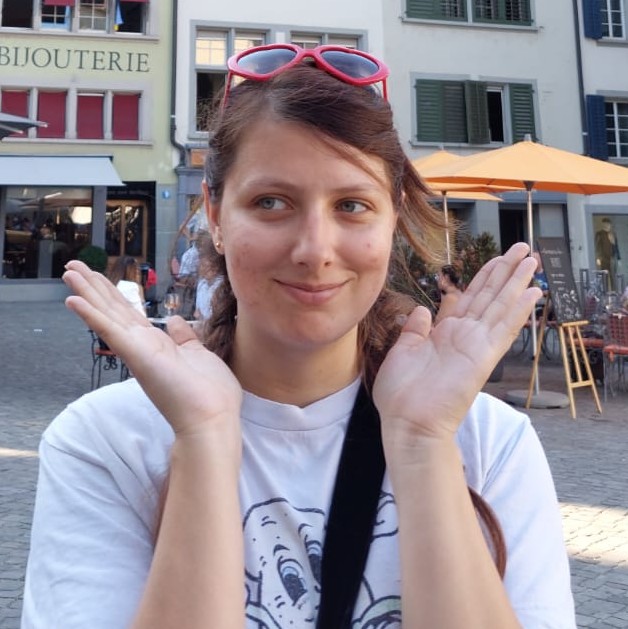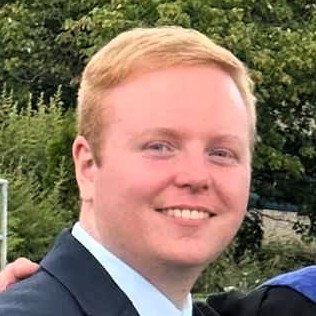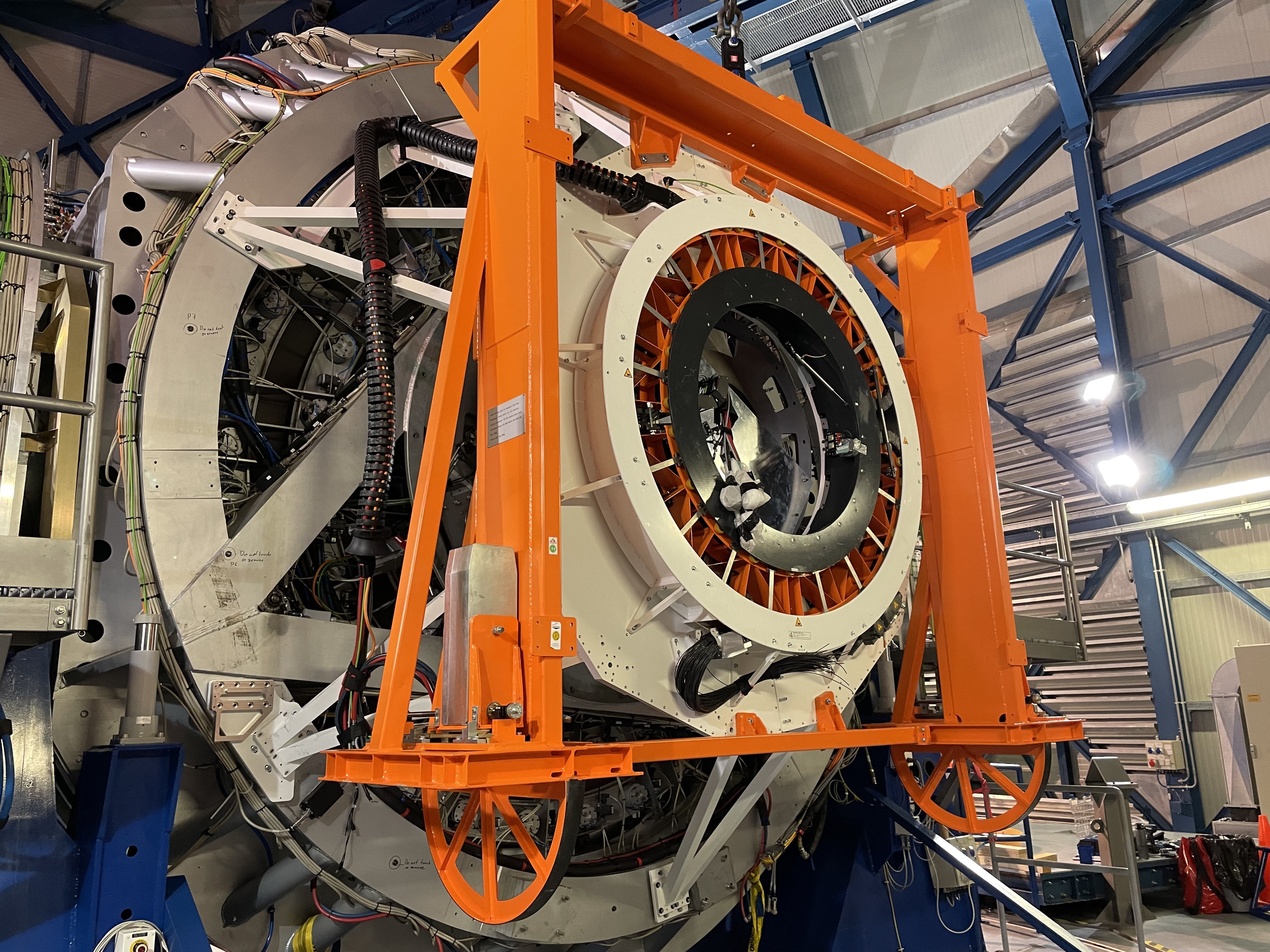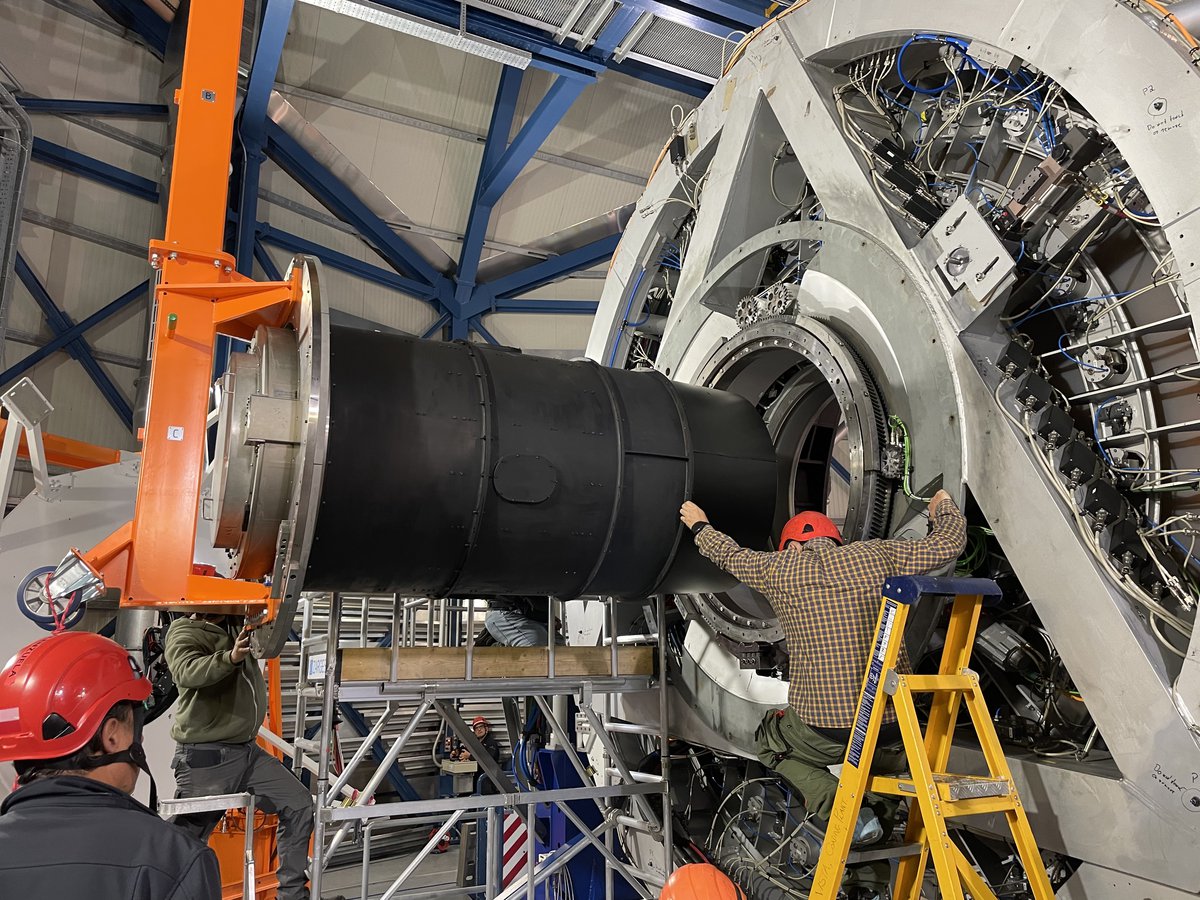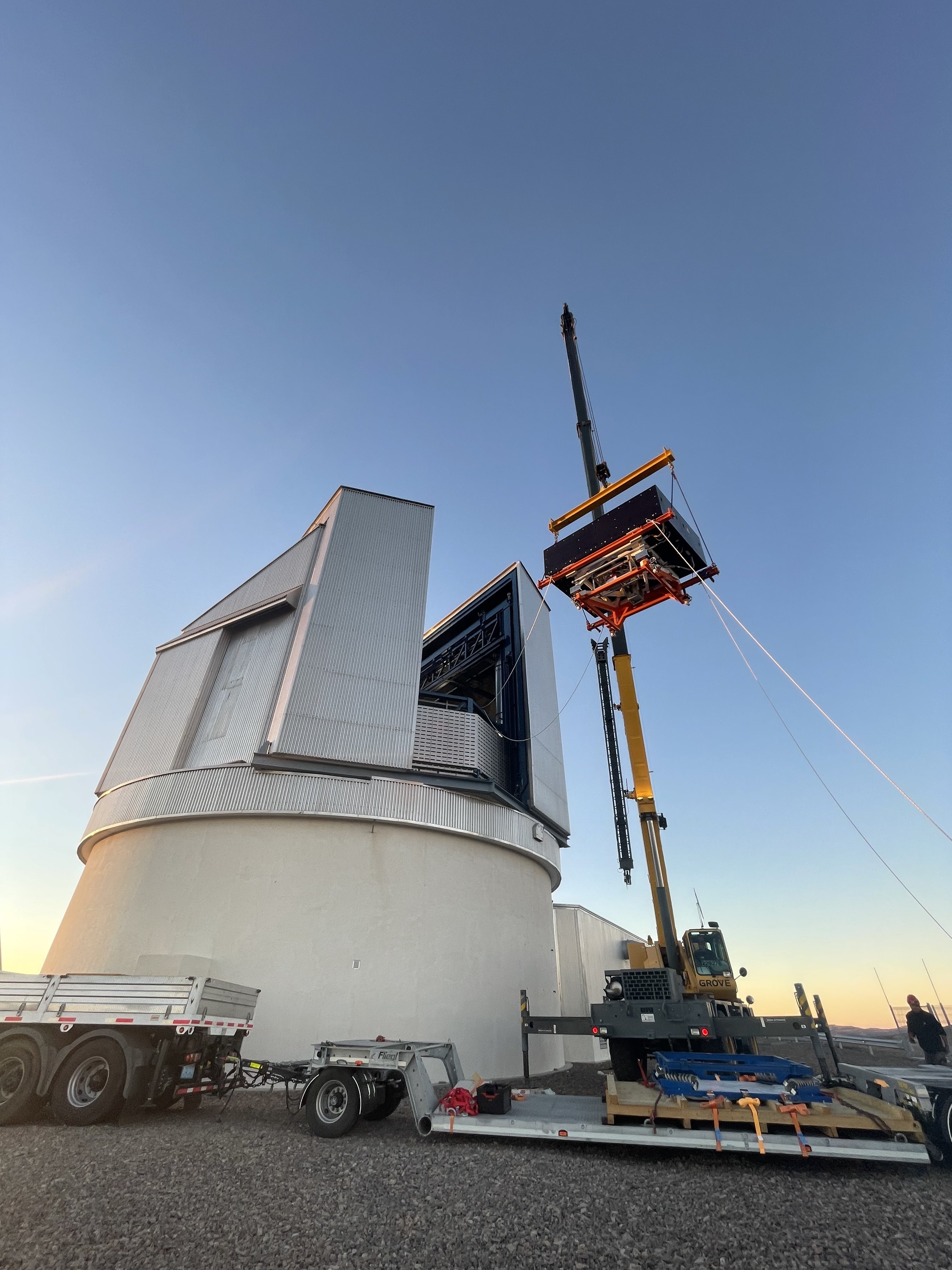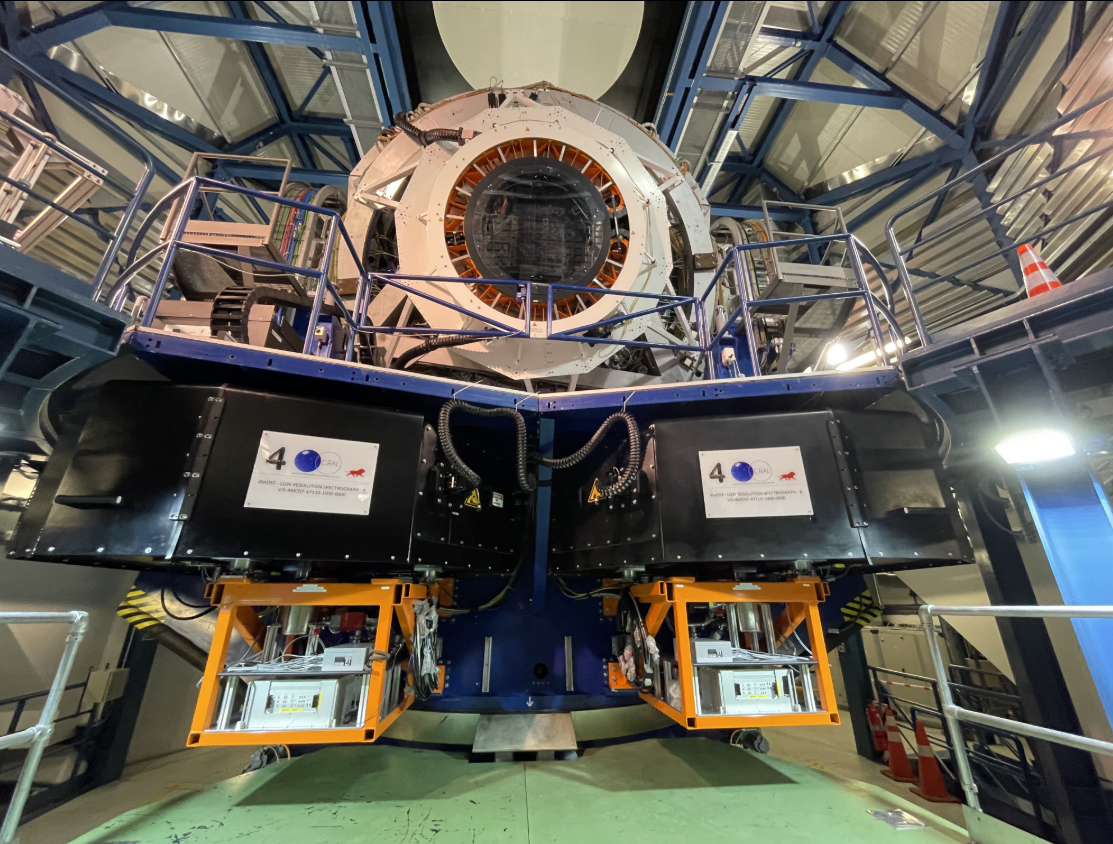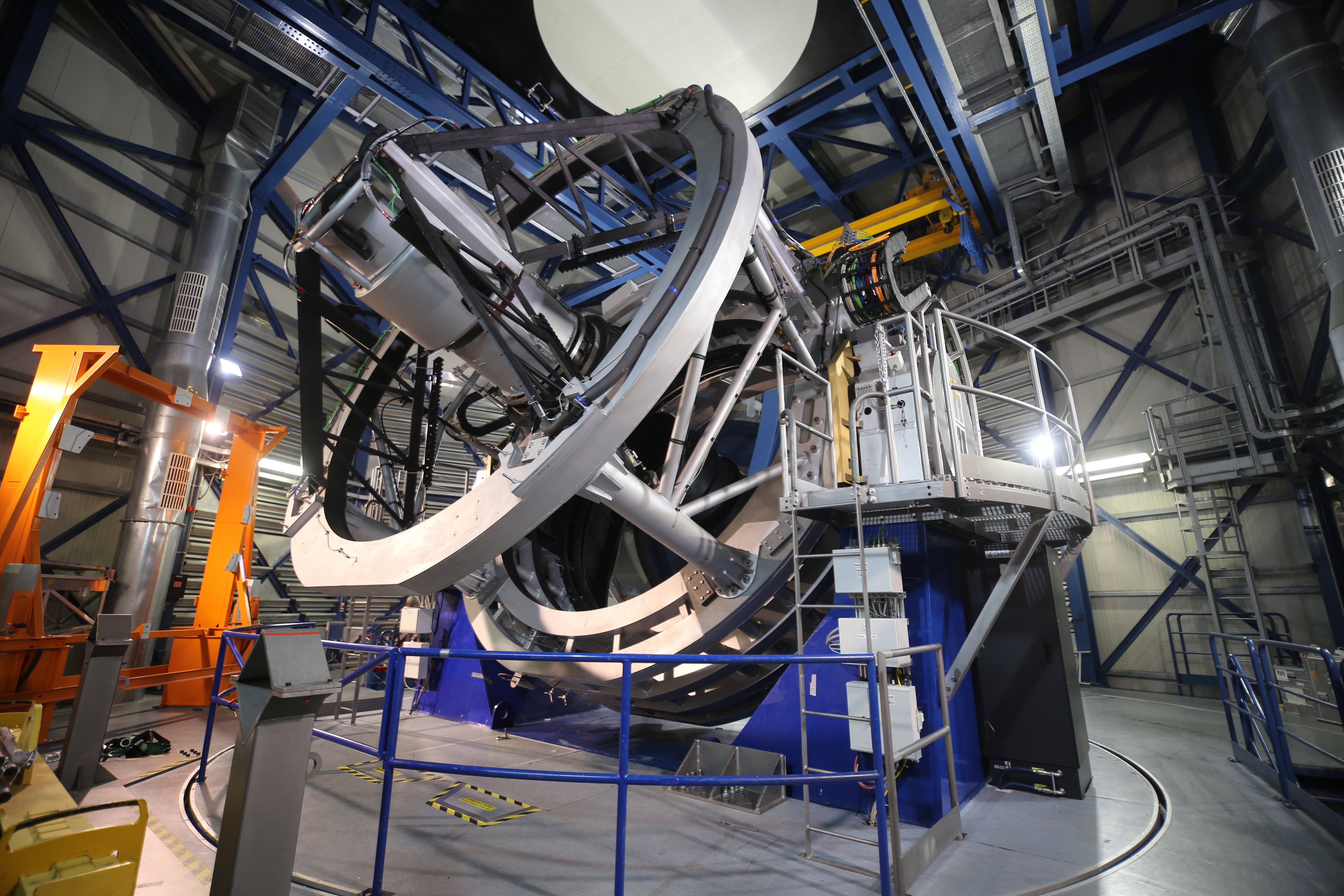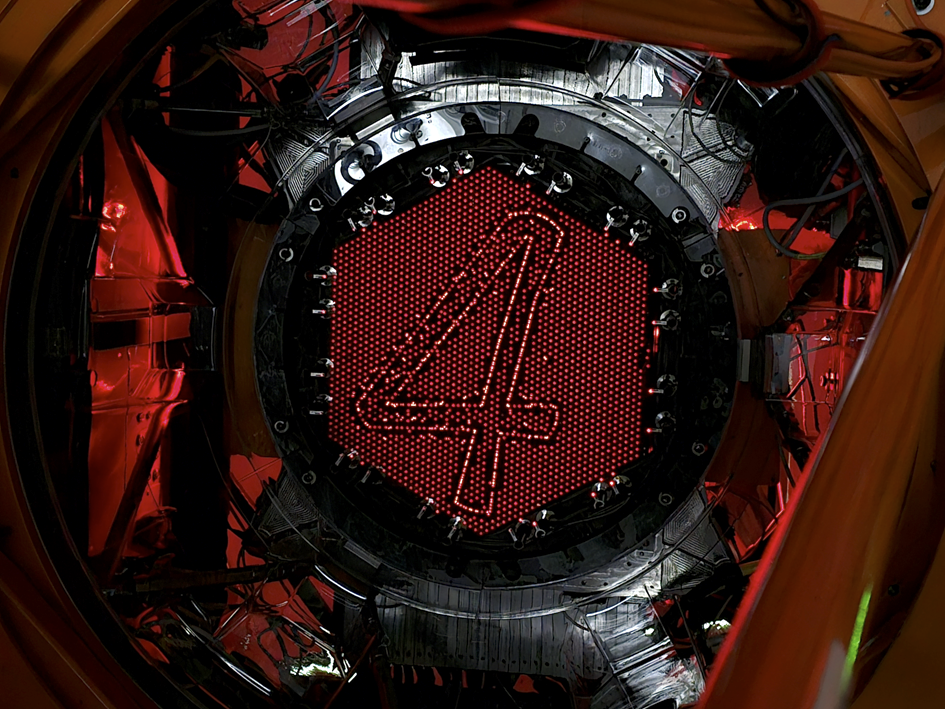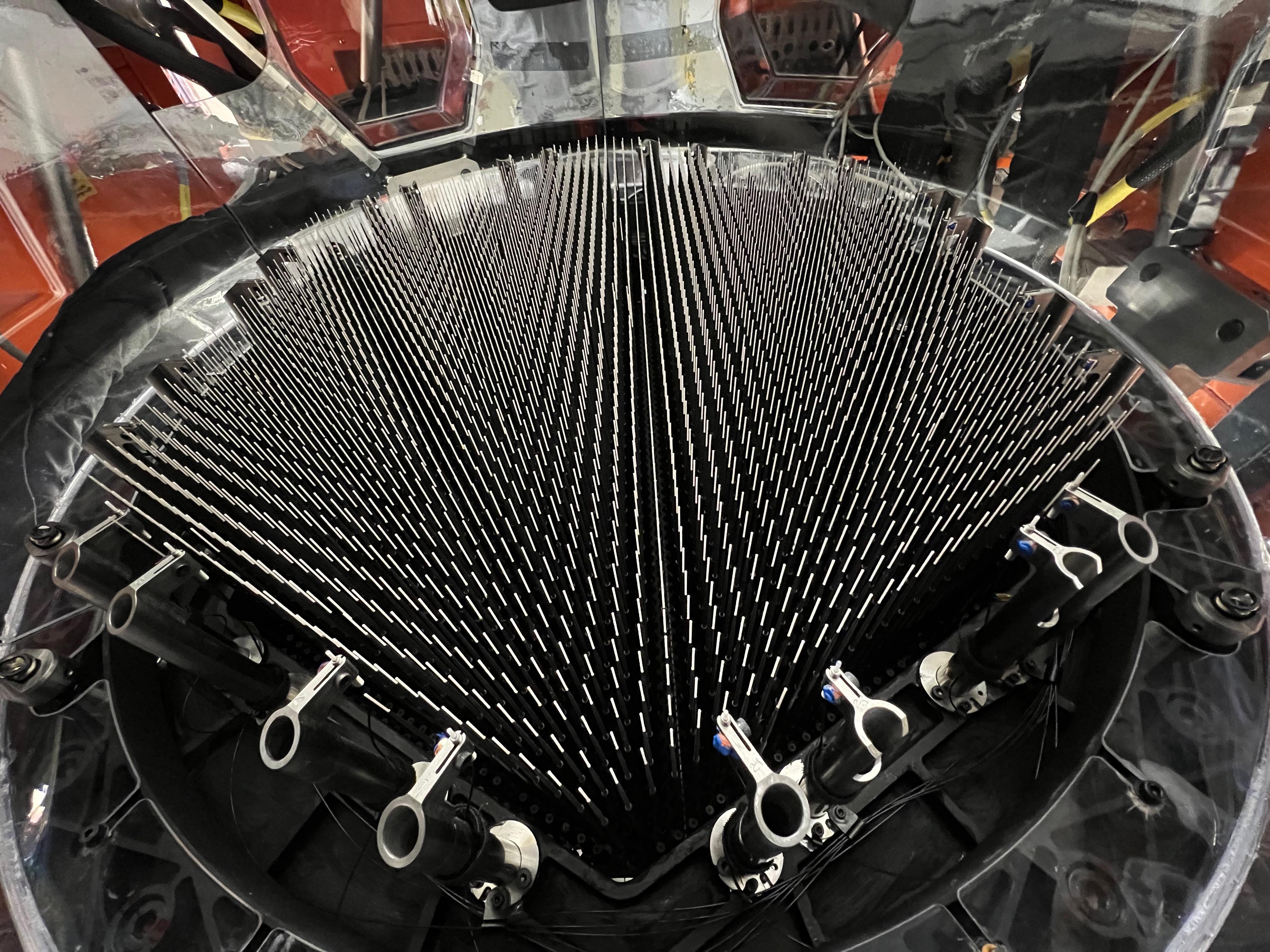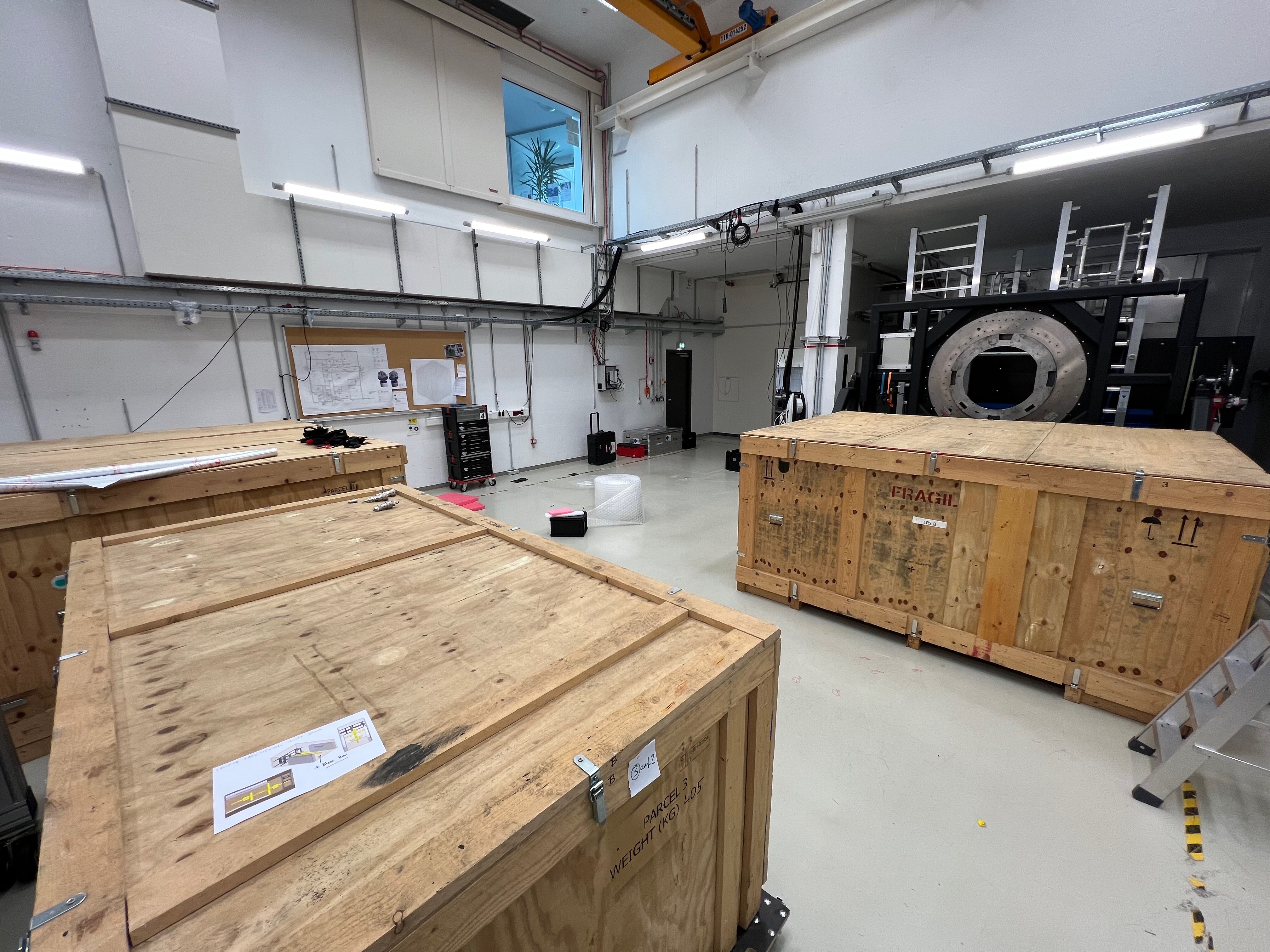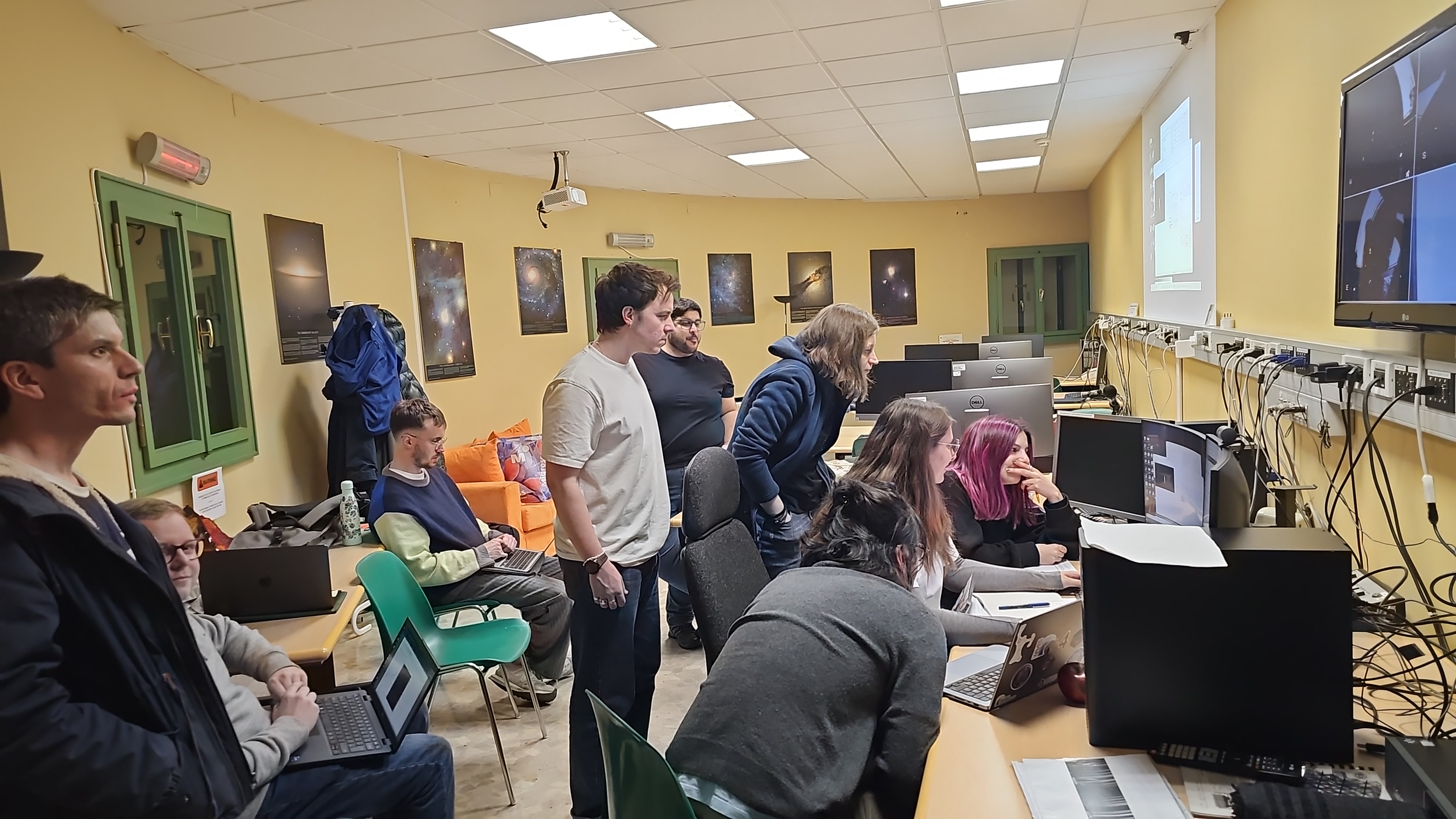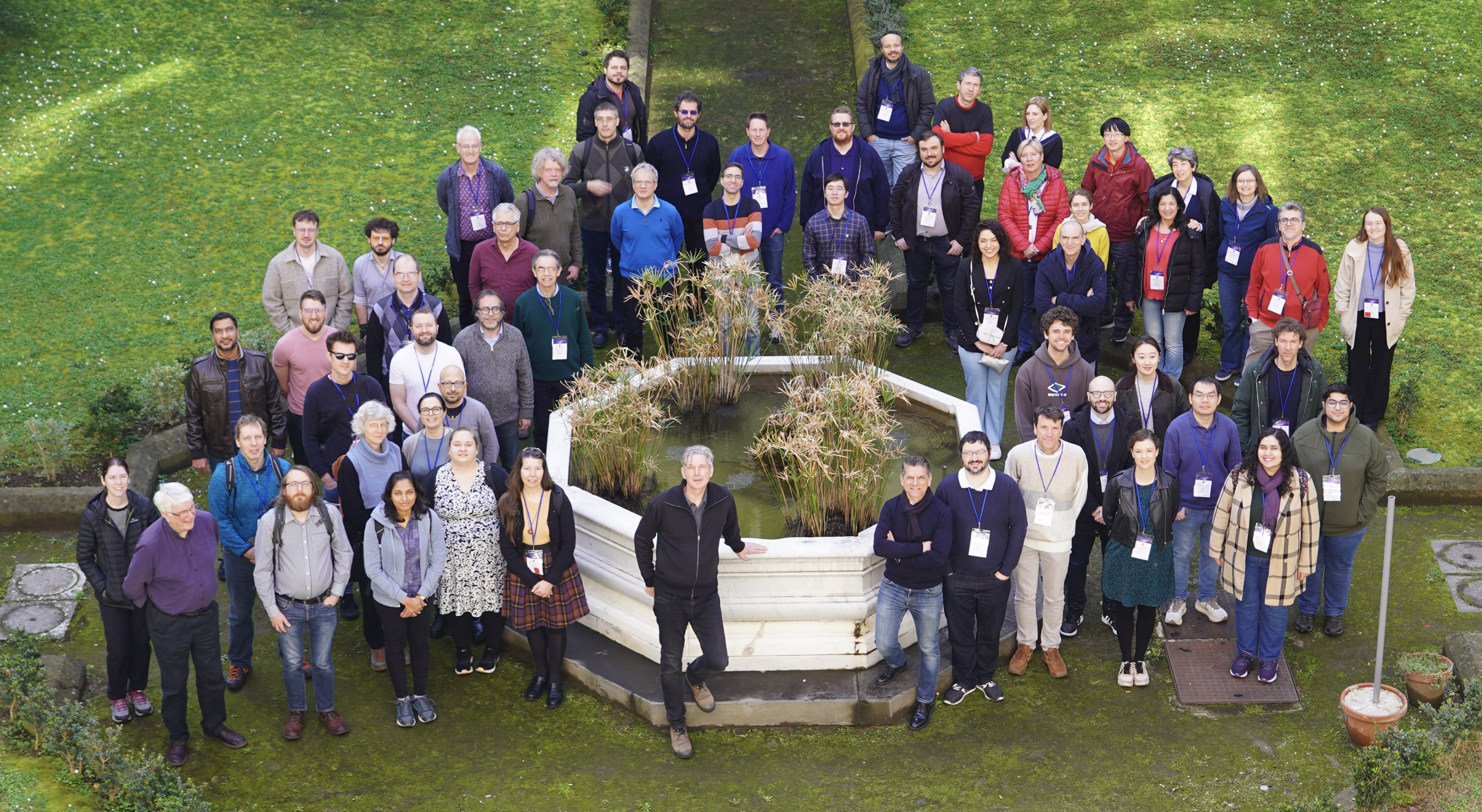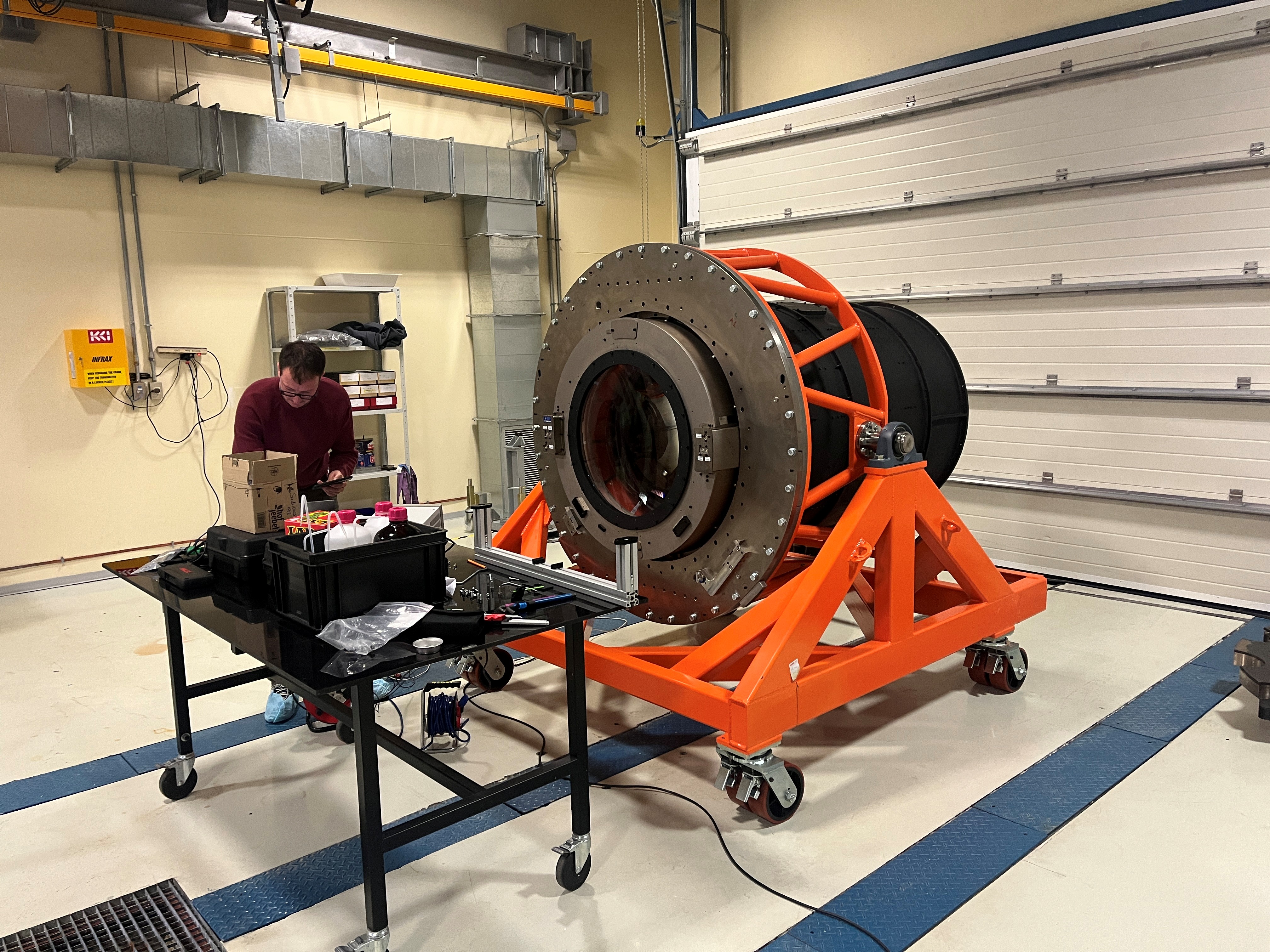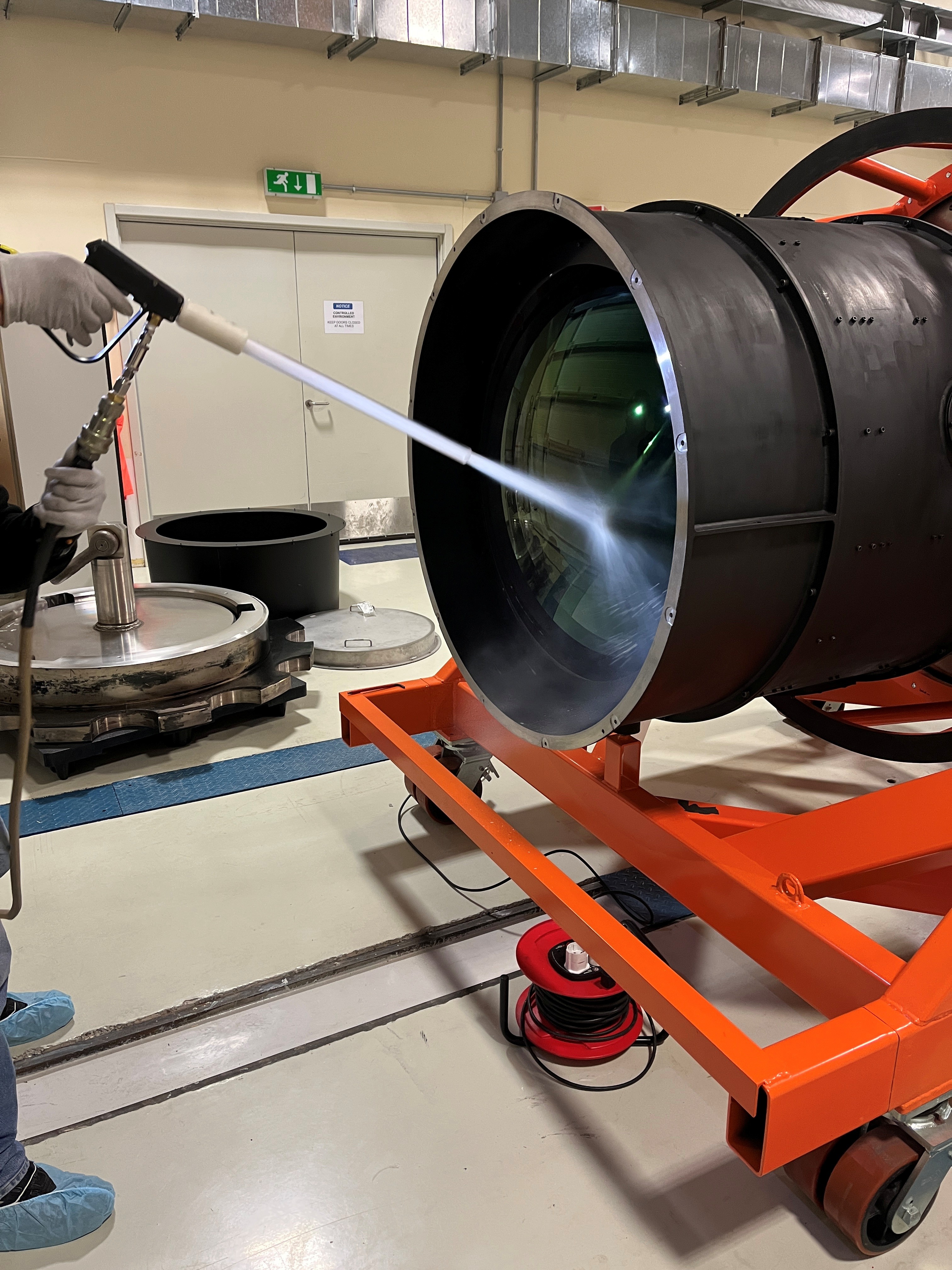News
4MOST Milestone: 4MOST Captures First Light
2025-10-21
From ESO's VISTA telescope in Chile to the First Light sky region. Here, 4MOST used its 2400 fibres to capture the light of many different objects for further spectral analysis, including the centre of the Sculptor Galaxy, stars in the globular cluster NGC288 and the active core of a distant galaxy. (Credit: AIP/R. de Jong, AIP/K. Riebe, AIP/A. Saviauk, CRAL/J.-K. Krogager)
Roelof de Jong, 4MOST Principal Investigator, Milky Way section head at AIP
“It is incredible to see the first spectra from our new instrument. The data looks fantastic from the start and bodes well for all the different science projects we want to execute. That we can catch the light that has travelled sometimes for billions of light years into a glass fibre the size of a hair is mindboggling. An incredible feat only made possible by an incredible development team. Can’t wait till having the system operating every night.”
Joar Brynnel, 4MOST Project Manager
“Reaching the First Light milestone is a wonderful achievement after more than a decade of intensive efforts. It is hard to put in words the excitement realising that the facility not only meets, but even exceeds the required performance. It has been a true privilege to manage this huge consortium for over a decade. Without the commitment by all team members and institutions involved, which has genuinely been beyond expectations, we would not have been able to deliver 4MOST to the VISTA telescope in such good shape. I am really looking forward to the exciting results from 4MOST over the years to come!”
Lisa Kelsey, Institute of Astronomy, University of Cambridge, co-lead of the 4MOST Science Communication Group.
“This is such an exciting time to be an astronomer, as 4MOST and other next-generation telescopes come online. It’s taken a long time and a huge team to get here, but we can’t wait to get to work on some exciting new science.”
On October 18 2025, the 4-metre Multi-Object Spectroscopic Telescope (4MOST) facility, installed on the VISTA telescope at the European Southern Observatory’s (ESO) Paranal Observatory in Chile, obtained its first light. This milestone is a crucial step in the life of any telescope marking the moment it is ready to begin its scientific journey. Moreover, 4MOST does not simply take images of the sky; it records spectra, capturing the light of each object in every individual colour. With this capability, it can unravell the light of 2,400 celestial objects simultaneously into 18,000 colour components, allowing astronomers to study their detailed chemical composition and properties.
Once fully operational, 4MOST will investigate the formation and evolution processes of stars and planets, the Milky Way and other galaxies, black holes and other exotic objects, and of the Universe as a whole. By analysing the detailed rainbow-like colours of thousands of objects every 10–20 minutes, 4MOST will build a catalogue of temperatures, chemical compositions, velocities and many more physical parameters of tens of millions of objects spread across the entire Southern sky.
Development started in 2010 and is the largest multi-object spectroscopic survey facility in the southern hemisphere. It is unique in its combination of large field of view, number of simultaneous observed objects, and number of spectral colours simultaneously registered. The facility has been designed to operate for at least the next 15 years.
The Leibniz-Institut für Astrophysik Potsdam (AIP) is the lead institute of the 4MOST Consortium that has built and will scientifically operate the facility. Next to overall management, AIP has been involved in many aspects of the facility, like its wide field camera with six lenses that are up to 90 cm in diameter, its guiding and focussing system, and its fibre system that contain more than 2500 glass fibres, each with a diameter of a human hair. AIP is also strongly involved in determining 4MOST’s operations scheme, including observing planning and data archiving.
About the First Light observations

Left: This spectrum is of the nucleus of the Sculptor Galaxy. Center: Spectrum of a star in the globular cluster NGC288. Right: This spectrum of a distant galaxy shows signs of an active nucleus surrounding its central massive black hole. (Credit: AIP/R. de Jong, CRAL/J.-K. Krogager)
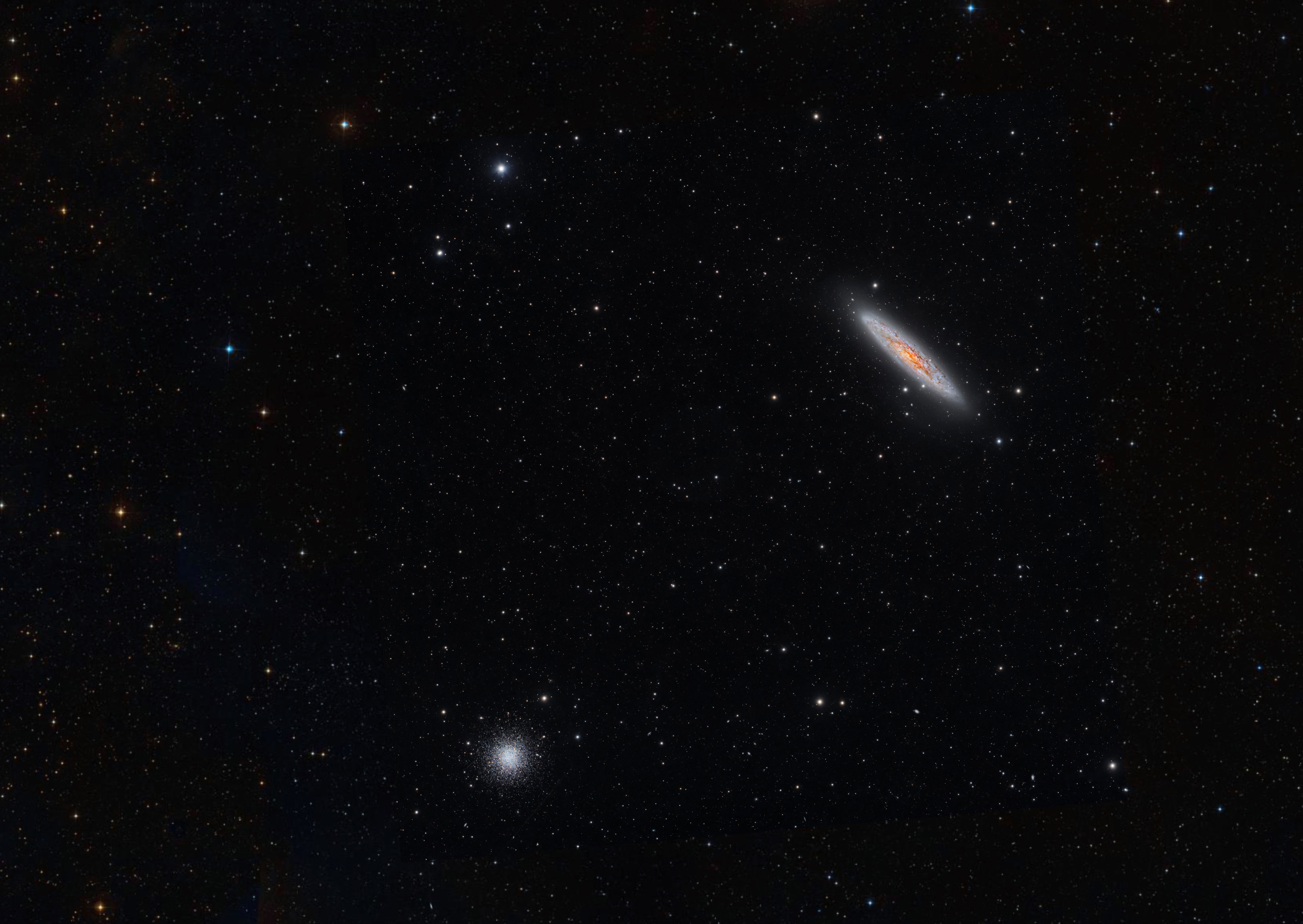
The 4MOST first light field containing the Sculptor Galaxy and the globular cluster NGC288. (Credit: AIP/Background: Harshwardhan Pathak/Telescope Live)
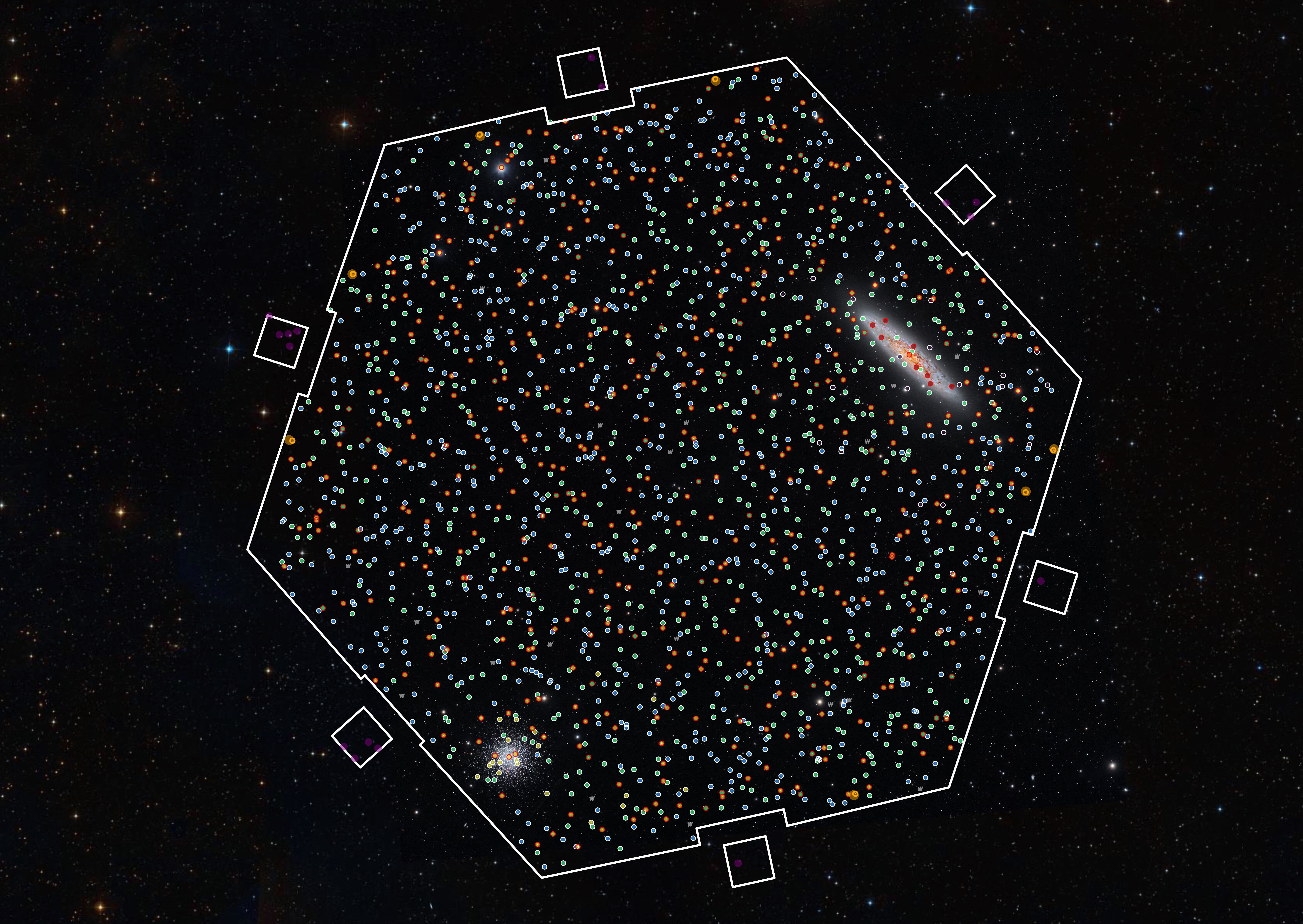
The hexagonal 4MOST field-of-view and the many objects (marked with different coloured dots for different types of objects). 4MOST collected a spectrum for each of these individual objects, allowing us to study their properties such as chemical composition or temperature. (Credit: AIP/Background: Harshwardhan Pathak/Telescope Live)
The First Light observations exemplify the unique capabilities of 4MOST: its ability to observe a very large field of view and its capability to investigate a large number of very different objects and science cases simultaneously in great detail.
One of the objects dominating the First Light observation of 4MOST is the elongated galaxy NGC253, also called the Sculptor or Silver Coin galaxy. Except for the Magellanic Clouds, it is the galaxy with the largest apparent diameter in the southern sky with nearly the same diameter as the moon, only much fainter. It was discovered by Caroline Herschel in 1783, is at a distance of about 11.5 million lightyears, and is known to currently form a lot of new stars. The 4MOST observations also capture a super star cluster, various hot and cold stars and their movements, and gas glowing from newly formed stars in this galaxy.
The other large object seen in the field is the Globular Cluster NGC288, a very dense group of about 100,000 very old stars in the outskirts of the Milky Way. It formed about 13.5 billion years ago in the very earliest phases of the formation of the Milky Way. Its stars contain very small amounts of most chemical elements heavier than hydrogen and helium, reflecting it’s pristine composition.
Next to these two very large objects, 4MOST obtained spectra of more than two thousand other objects in its first science observation. These include spectra of a large variety of bright and faint stars in our Milky Way, allowing scientists to determine their temperature, mass, diameter, velocity, age and evolutionary stage, and chemical composition. Beyond the Milky Way, spectra of a pair of overlapping galaxies at 900 million lightyears were obtained, as well as spectra of more than a thousand other galaxies near and far –up to 10 billion lightyears!– to determine their distance, internal velocity, and star formation history or the mass of their central black hole.
Users, Surveys, Science
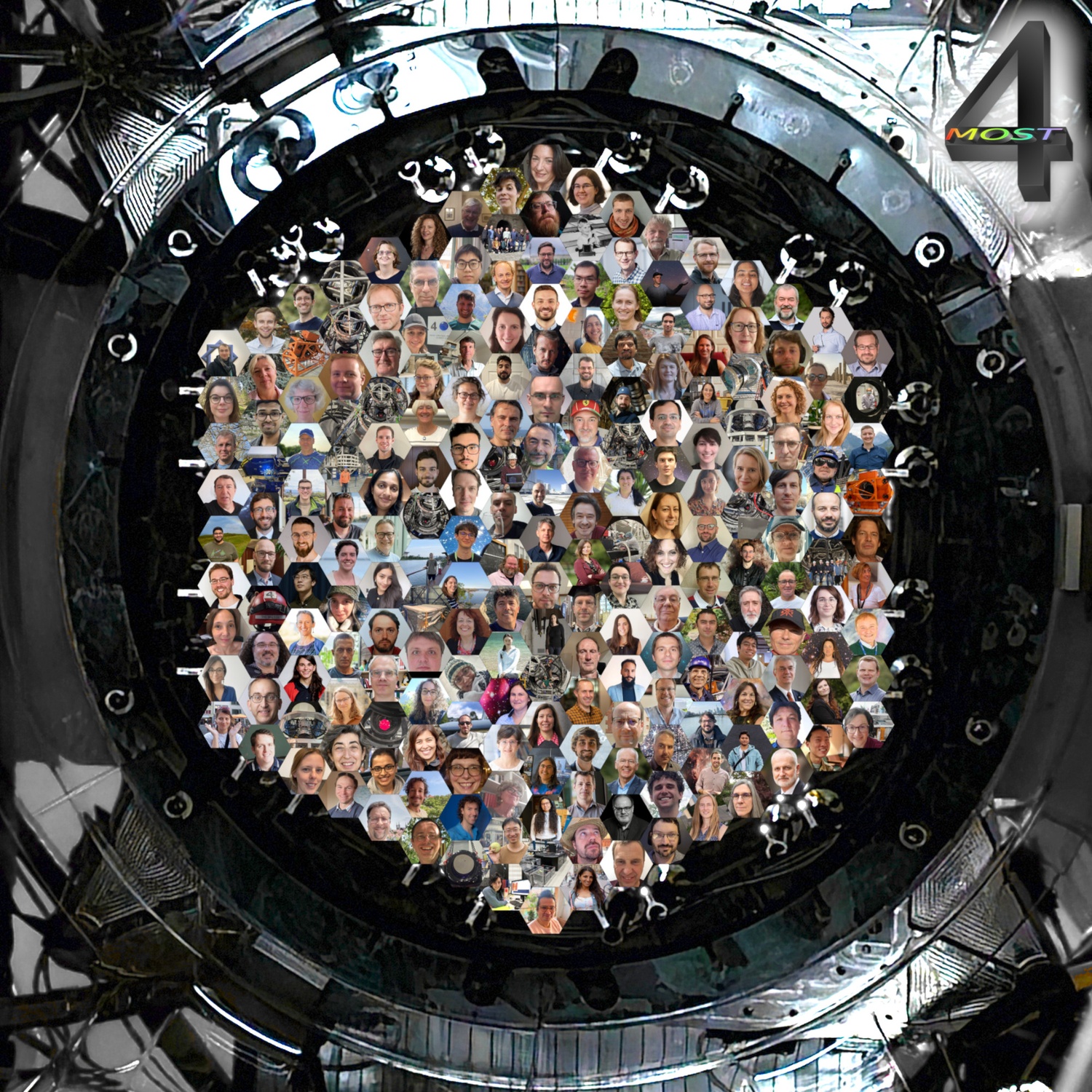
An image of the 4MOST instrument, overlaid with hexagonal images illustrative of individual fibres. Each hexagon contains the face of a person involved in 4MOST, symbolising the people behind the project. (Credit: Moritz Gammel)
The 4MOST science team consists of more than 700 investigators from universities and research institutes around the world. In its first five years of operations, 4MOST will conduct 25 different science programmes, ten designed by institute members of the consortium that built the instrument, whereas the other fifteen programmes were selected by an external committee of astronomers. Uniquely, the multi-fibre nature of 4MOST enables many science programmes to be observed simultaneously. For example, a few fibres can be used to study rare objects, while at the same time another program can use most other fibres to make large statistical samples of stars or galaxies. Highlighted 4MOST science cases are the origin of the chemical elements and the formation of the first stars, the growth of the Milky Way over cosmic time, the formation and evolution of galaxies and black holes, the make-up of the unseen Dark Matter that seems to encompasses most of the mass in galaxies, and the nature of Dark Energy that drives the accelerating expansion of the Universe.
About the facility
At the heart of the system, 4MOST uses 2438 optical fibres, each the size of a human hair, to catch the light of celestial objects. Light from each of these fibres is transported to the spectrographs that break up the light in its different colours. A large, new, nearly 1m-diameter optical camera lens system was installed in the VISTA telescope of the European Southern Observatory (ESO) in Chile to give 4MOST a field of view on the sky of 2.5 degrees diameter, five times larger than the diameter of the moon and one of the largest in the world for a 4m-class telescope. 4MOST will observe a new set of objects in the sky every 10–20 minutes using a fibre positioner that moves all fibres to observe new objects in less than 2 minutes. The fibres transport the light to three spectrographs that each observe 800 objects simultaneously, where their light is first broken up in red, green, and blue components and then in further detail to then be registered by large 36 Megapixels detectors. There are two spectrographs that cover the entire colour spectrum from the very blue all the way into the infrared (370–950 nm), whereas a third spectrograph looks at higher wavelength resolution in three selected colour bands to better measure chemical element abundances in stars.
Operations
Planning of 4MOST observations is done remotely from the Max Planck Institute for Extraterrestrial Physics (MPE) in Garching near Munich. A few minutes before the next observation needs to start a next field and new objects are optimally selected based on the latest weather and observing conditions information. Executing the observations and maintaining the instrument is the responsibility of the European Southern Observatory (ESO). The data obtained are transferred to the 4MOST data centre at the University of Cambridge, where they are analysed with an extensive set of software pipelines to extract physical parameters of the studied objects. The analysis results are then transferred to data archives at the Leibniz Institute for Astrophysics Potsdam (AIP) and ESO to be distributed to all project members and to the entire scientific community for scientific exploration.
Behnood Bandi, Postgraduate Researcher at the University of Sussex, Co-lead of the 4MOST Science Communication Working Group.
“I have been involved with 4MOST for five years, working on extragalactic research, commissioning, and science communication. As a PhD student at the University of Sussex and co-lead of the 4MOST Science Communication Working Group, it is thrilling to see 4MOST begin its first-light observing programme. This milestone reflects years of dedication across the consortium, and I am proud of our contribution to helping 4MOST open a powerful new view of our evolving Universe.”
Jessica Pilling, Postgraduate Researcher at the University of Sussex, member of the Commissioning Team and Science Communication Group.
“I have only been a part of the 4MOST community for 2 years, and it has been a real joy. I feel very lucky to have seen the journey of 4MOST, from separate parts in Germany to a massive instrument in Chile, observing the night sky for the first time. As well as Science Communication, I am also on the commissioning team, so I will be heading out to Paranal in about a month and will get to observe with 4MOST!! I absolutely cannot wait, and I will use this milestone of first light to thank the 4MOST collaboration, especially Genoveva (our commissioning lead) for giving a humble PhD student like me this fantastic opportunity!”
Harry Addison, Postgraduate Researcher at the University of Surrey, member of the Commissioning Team and Science Communication Group.
“Although I've only been a part of the 4MOST journey for 3 years, I've witnessed the dedication and hard work of the individuals and teams that have made 4MOST's First Light possible. Its amazing to think that only a few months ago 4MOST was in pieces at the AIP integration hall and now its installed on VISTA working as a coherent system. I'm very excited for the coming months, having been given the fantastic opportunity to travel to Paranal to work on the Commissioning of 4MOST and to be involved in 4MOST's journey towards science opperations!”
Consortium and Construction
The 4MOST facility is designed, built, and scientifically operated by a Consortium of 30 universities and research institutes in Europe and Australia under leadership of the Leibniz Institute for Astrophysics Potsdam (AIP). The main institutes involved in building and operating of the facility are:
- Leibniz Institute for Astrophysics Potsdam (AIP): consortium lead, telescope corrector and guiding system, metrology, control software, fibre system, and archive system
- Macquarie University / Australian Astronomical Optics (AAO): fibre positioner
- Centre de Recherche Astrophysique de Lyon (CRAL): low-resolution spectrographs
- European Southern Observatory (ESO): detector systems
- Max Planck Institute for Astronomy (MPIA): instrument control hardware
- Max Planck Institute for Extraterrestrial Physics (MPE): observation planning and remote operations
- Nederlandse Onderzoekschool Voor Astronomie (NOVA): calibration system
- University of Cambridge, Institute of Astronomy (IoA): data management
- University College London (UCL): Assembly and alignment of Wide Field Corrector
- Universität Hamburg (UHH), Hamburger Sternwarte: archive and user management
- Universität Heidelberg, Zentrum für Astronomie (ZAH): high-resolution spectrograph and instrument control software
All these institutes are also involved in the scientific analysis and exploration, as are the following major consortium partners: Durham University, Department of Physics, École polytechnique fédérale de Lausanne, Lunds universitet, Rijksuniversiteit Groningen, University of Bath, University of Western Australia, Uppsala unversitet, and minor consortium participants: Georg-August-Universität Göttingen, L'Observatoire de Paris, Laboratoire des Matériaux Avancés, Max-Planck-Institut für Radioastronomie, University College London, Universität Potsdam, University of Sussex, University of Tartu, University of Warwick, Lancaster University, University of Portsmouth, University of Southampton, and Queen’s University Belfast.
Countdown to 4MOST First Light
2025-10-14
First Light Release:
The road to discovery is rarely straight, but every twist and turn has brought us closer. We are nearly there, 4MOST is approaching First Light! All the years of planning, engineering, testing and teamwork are bringing us close to the moment that will enable transformative science across the southern sky. A huge thanks to everyone whose dedication has brought us to this milestone!
Stay tuned for First Light!
4MOST Milestone: AIV Completion - Beginning of Systems Verification
2025-09-25
On 17th September 2025, installation of 4MOST onto the VISTA telescope was completed. This marks the end of the Assembly, Integration, Verification (AIV) phase of 4MOST's journey towards observing the Universe. As Joar Brynnel remarks, "this has been a long process, with phased implementation of hardware and software on Paranal".
AIV initially began on 2nd June 2024 with installation of the Cassegrain Cable Wrap. Installation of the Wide-Field Corrector, the Guiding and Wavefront Sensor system, and the control hardware and software followed in October and November 2024, marking an end to phase 1 of AIV. AIV phase 2 began in June 2025, which saw installation of more control hardware and software, Metrology system, Calibration system, Long Fibre Feed, Fibre-Positioner (AESOP), Low-Resolution Spectrographs, and lastly the High-Resolution Spectrograph.
Allar Saviauk and the AIP have done a fantastic job of documenting the AIV process, taking many pictures and producing multiple short films that give amazing insights into the work that has gone on behind the scenes:
The end of AIV means that 4MOST now enters the System Verification phase. Mark Cunningham (System Verification lead) summarised System Verification as the phase "where all the AIV work gets put to the test", with tests designed and carried out to ensure that all of the subsystems "work together as one coherent system". Some of the tests that will be conducted include fibre-to-target alignment, fibre positioning precision, checking for any stray light, and verifying the behaviour of the atmospheric dispersion corrector.
The completion of AIV serves as a reminder of the collective efforts that make projects like 4MOST possible. We wish the System Verification team good luck as they advance 4MOST closer to operations!
4MOST Social Media Launch
2025-09-18
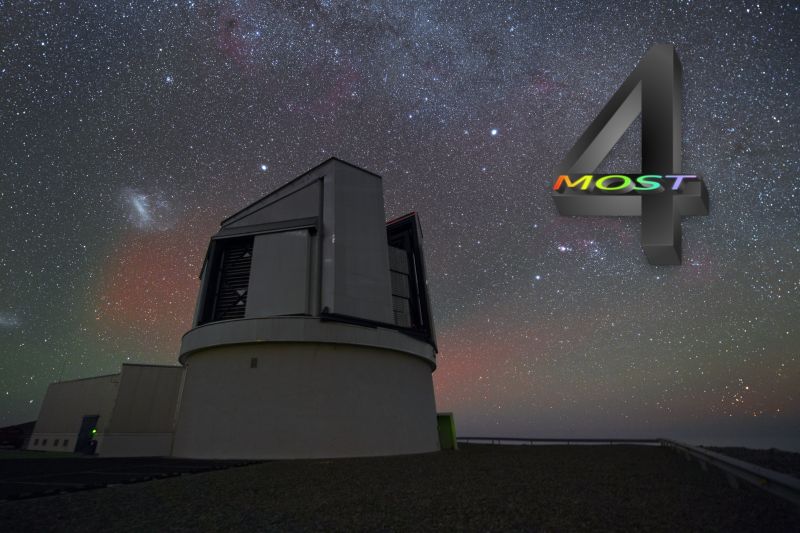
The VISTA telescope, where 4MOST will explore the cosmos with unprecedented detail. (Credit: Y. Beletsky, ESO).
The Science Communication working group are excited to announce that 4MOST is now active on multiple social media platforms. You can now follow 4MOST on LinkedIn, Bluesky, and Instagram to stay up to date with news, project updates, behind the scenes insights, science highlights, and learn about the team behind it all.
Find us here:
We are excited to share with you the work being done across the 4MOST community!
4MOST installation on VISTA
2025-09-12
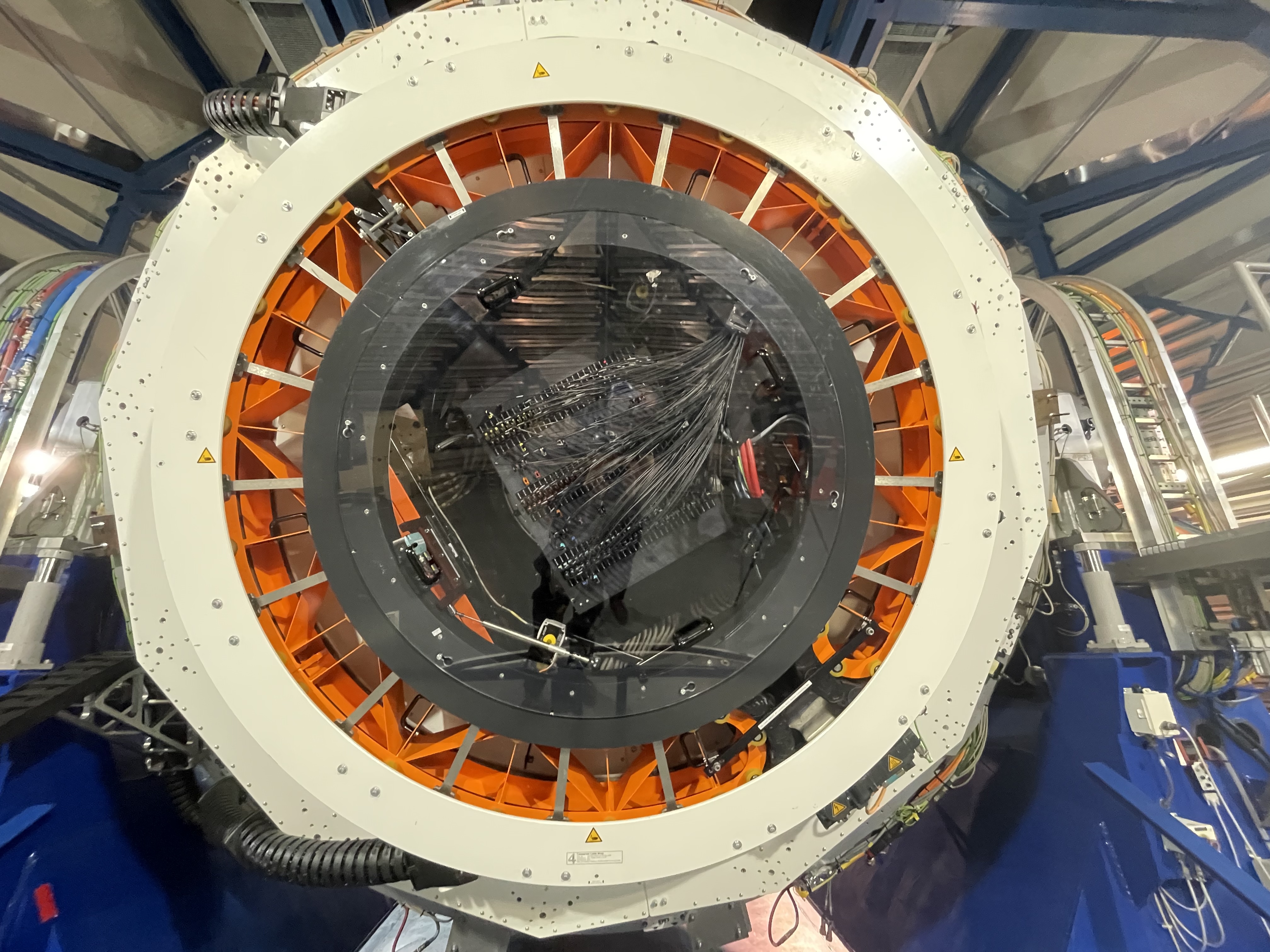
The installed cassegrain cable wrap (white and orange parts) with the fibre positioner and its near 2500 fibres encased within (Credit: Allar Saviauk).
In June 2025 the last subsystems of 4MOST were shipped from the AIP, Germany, to Paranal, Chile. We are glad to report that all of the shipments arrived safely at the VISTA telescope and that 4MOST in its entirety is now at Paranal.
With the arrival of the final shipments at Paranal, installation of the various subsystems has been carried out by the many specialist teams. The metrology system that monitors the fibre spine positions was installed and calibrated using the focal surface test tool. The test tool was then removed from the focal plane and the team from AAO reintegrated, tested, and installed the fibre positioner onto the telescope. A team from MPIA then installed 4MOST's electronic cabinets and wiring for all of the systems. Finally, the cassegrain cable wrap and the almost 2500 fibres were installed, with the fibres being connected to the fibre positioner.
The recent shipments also included the two low resolution and the high resolution spectrographs. As these were dismantled for shipping, they have been reassembled and aligned in the New Integration Hall at Paranal Base Camp by teams from CRAL and AIP. The two low resolution spectrographs have been reassembled and tested, meeting all of their specification requirements and even exceeding many. On the 5th and 7th of September the low resolution spectrographs were craned into the VISTA dome and installed side by side under the main telescope platform. The high resolution spectrograph currently remains in the New Integration Hall for final checks before being installed on VISTA in the coming weeks.
To demonstrate the hard work that has been taking place at Paranal, Allar Saviauk has produced a short film documenting the recent installation work. The film can be viewed at https://cloud.aip.de/index.php/s/3GF8B3jQiKbTbec.
With the installation of 4MOST nearing completion, we now look forward towards celebrating everyone's hard work with 4MOST's first light!
ESO Picture of the Week: Fantastic 4MOST
2025-07-23
On the 22nd July 2025, 4MOST featured in ESO's picture of the week. With work well underway to install 4MOST on VISTA, we were treated with an image of the installed fibre positioner, with the backlit fibres positioned to create the Fantastic 4 logo.
In addition to the image, ESO and 4MOST released a video showing the fibre positioner in action as it created the iconic logo. It reveals the precise and coordinated motion of the 2436 fibres as they moved gracefully into place.
ESO's picture of the week article, image, and video can be found at:
- Article and image: https://www.eso.org/public/images/potw2529a/
- Video: https://www.eso.org/public/videos/potw2529a/
This marks an exciting milestone in 4MOST's journey, highlighting the tremendous work and dedication from everyone involved over the years. A huge congratulations!
4MOST Milestone: Second Major Shipment to Chile
2025-06-18
On the 9th May 2025, ESO gave the green light to start packing some of the subsystems at the AIP, Germany, for shipment to Paranal, Chile.
Work began on detatching the fibre system from the fibre positioner and removing the fibre slits from the spectrographs. The smaller subsystems (detectors, fibre feed, electronics cabinets, calibration system, metrology, and secondary guiding) were then shipped by airfreight on the 20th May and safely arrived in Santiago, Chile, on the 29th May.
On the 13th June, ESO and the 4MOST consortium held a meeting regarding preliminary acceptance in Europe (PAE). 4MOST successfully passed PAE, initiating the final shipment which predominantly contains the spectrographs.
With the AIP integration hall now looking rather empty, we are one step closer to the start of operations. In the coming months, we look towards installing and commissioning 4MOST on VISTA.
SITCOM Observing School
2025-04-22
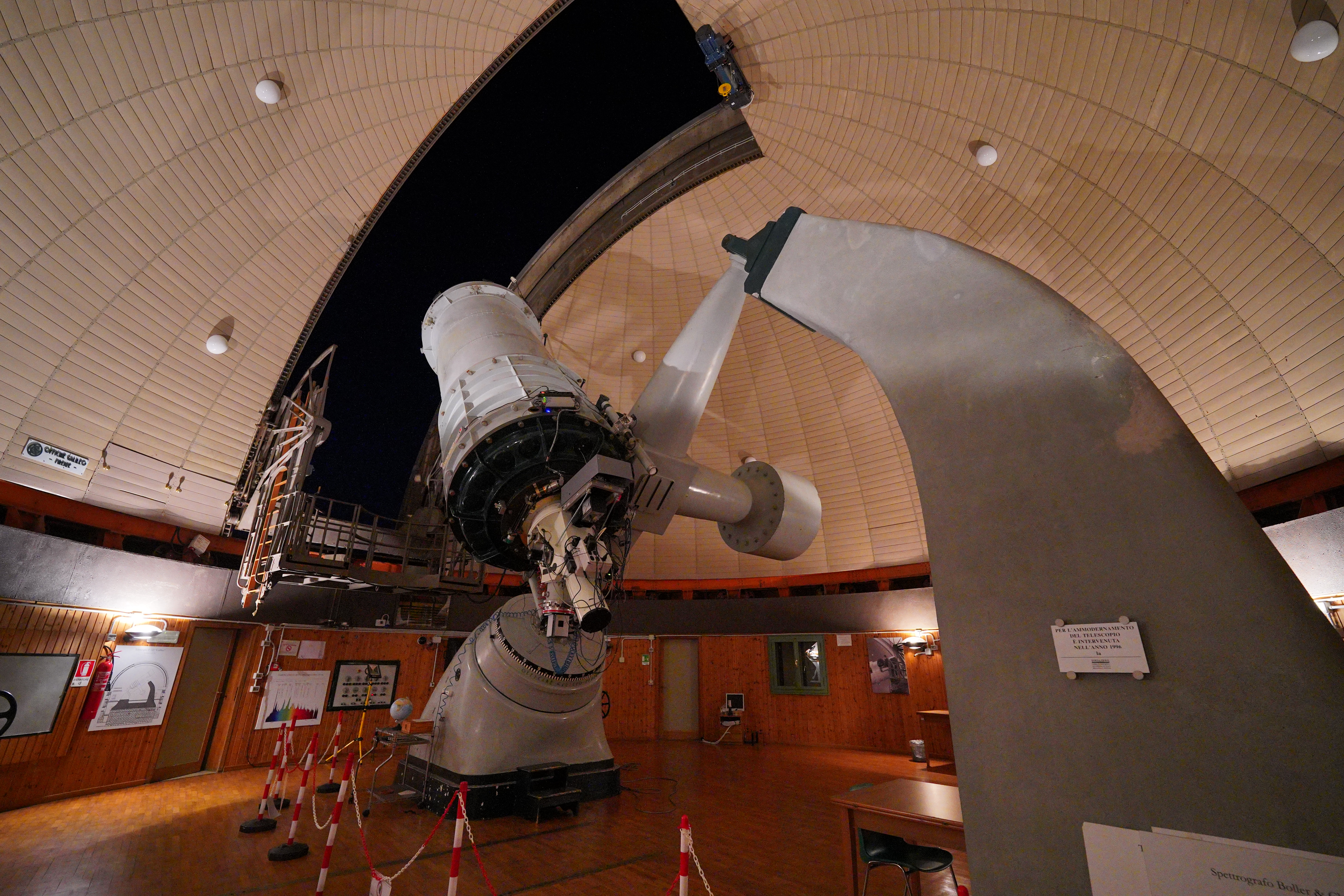
The 1.22m Galileo telescope used by the members of SITCOM during the observing school. (Credit Romain Lucchesi)
During the week beginning 7th April, nine members of SITCOM were hosted at the Astrophysical Observatory of Asiago for an observing school. For some members the school provided them with their first observing experience, while it gave other members a chance to refresh their observing knowledge.
During the school the team learnt the basics of observing, including how to determine if and when a target is most optimal to observe, the calibration data that is required for the data reductions, how to setup and observe using the 1.22m Galileo telescope at the Astrophysical Observatory of Asiago, and finally how to reduce the observations.
Using what they had learnt, they planned and executed three nights of observations using the 1.22m Galileo telescope. The team observed a number of targets including galaxies such as NGC4565 and M104, planetary nebular, binary stars, and transient events. In particular, the group observed three objects of high interest: Nova X SER, T Corona Borealis, and an unclassified supernova-like transient. The unclassified transient was initially classified as a supernova II and continues to be monitored by staff at the Astrophysical Observatory of Asiago.
The attending SITCOM members thank Marica Valentini for organising the school, and to the staff at the Astrophysical Observatory of Asiago for hosting.
Science Team Meeting 2025
2025-03-13
The most recent 4MOST Science Team Meeting took place on February 24th-28th 2025 at the University Federico II, Italy, and online.
As 4MOST nears the start of operations, this meeting focused on the ongoing and future preparations required for a successful survey start. There were many in-depth discussions surrounding the survey strategy and simulations, with surveys communicating and converging on the future progression of the strategy and simulations. Plans for the phases leading up to the start of operations were discussed, with sessions focusing on the plans for commissioning and operation rehearsals.
Although the meeting primarily focused on the technical preparations, there were also sessions focused on science. There were discussions regarding the plans for DR0, the publication process, and the communication of 4MOST science to public audiences. Additionally, the wide range of science talks displayed the ongoing and future science projects that 4MOST will facilitate. All available presentations and recordings can be found on Docushare.
Overall, this science team meeting was a success, although it highlighted that there is still plenty of work to be done before the start of operations.
4MOST Wide Field Corrector checks out
2025-03-06
During the 4MOST hardware integration campaign on Paranal in October 2024, one of the verification measurements done on Paranal during the incoming inspection was the measurement of the Wide Field Corrector optical throughput. At the time, the result of this measurement indicated a loss of optical throughput compared to reference measurements done in Potsdam before shipment. Nevertheless, the WFC was installed on the VISTA telescope and telescope re-commissioning has been ongoing since then.
Possible reasons for the measured loss of throughput have been intensively investigated over the past months, however, since we had no physical access to the WFC, it was not possible to make tests to better understand the root cause of the problem. After discussions between the Consortium and ESO, it was decided to remove the WFC from the VISTA telescope and move it to a clean room on Paranal to investigate the issue. Removing the WFC from the telescope is a complex procedure involving removal of the Cable Wrap system (CaCW), the 4MOST test camera (FSTT), the Guiding and WFS unit, and finally the WFC itself. On 2 March 2025, a team from AIP arrived on Paranal to carry out this work in collaboration with ESO staff.
On 4 March 2025, the WFC optical throughput was re-measured. We are very pleased to report that the results confirm the Potsdam measurements, and the WFC performance is now verified to be nominal and in specifications. Over the next couple of days, we will reinstall all the components on the telescope and the final steps of VISTA re-commissioning can be carried out as planned.
We used the opportunity in the clean room to clean the L1 front and L4 back surfaces with CO2 snow to remove fine dust, as shown in the photo below.
